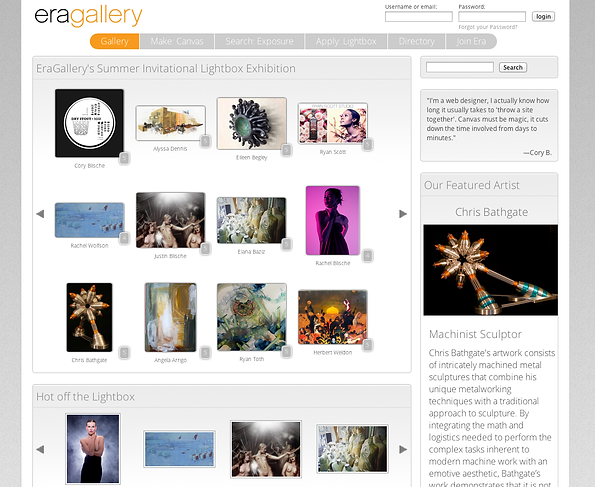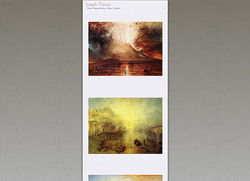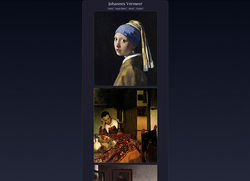

EraGallery Main page circa 2013.

EraGallery Lightbox page circa 2013.

Early site sketch, note the absence of Exposure and Canvas's working title "Frame IT".
 |  |
|---|---|
 |  |
 |  |
 |  |
 |  |
 |  |
 |  |
 |  |
 |  |
 |  |
 |  |
 |  |
 |  |
 |  |
 |  |
 |  |
 |  |
 |
 When viewers select an image to promote they tag it with up to three reasons as to why they picked it. |  The artists that received the most votes are promoted to the final exhibition. |
|---|---|
 When an artist receives enough tags of a given type they earn awards. Awards "level up" over time. |  Images are dragged into the Exposure search box, then results are returned below. |
EraGallery
2009-2014
View an incomplete archive of EraGallery
Founded in 2009 by James Kafader and myself, EraGallery was a modern web hosting and promotional solution for fine artists and creative professionals. It consisted of three services: Lightbox, Exposure, and Canvas.
My responsibilities for EraGallery included UI/UX design, marketing, customer support, social media promotion, as well as day to day site administation. The only aspect of the site I wasn't involved in was writing executable code.
I created this video as part of of EraGallery's advertising campaign. It began as a set of storyboards,and a script. I then sourced stock images, created site demos in iShowU HD, photographed the models, and comissioned the voiceover to be recorded. Last I edited it together in Final Cut Pro.
When the EraGallery project concluded I was working on a second version of the video. Our analytics data suggested that we should decrease the running time to about one minute and I wasn't satisfied with the audio quality of the voice over.
Canvas
Canvas was a free-form website building sweet similar to today's Wix or Square-Space site builders. It allowed users to create rich websites by simply dragging and dropping elements. This video was one of a series of help tutorials.
Canvas consists of roughly 50,000 lines of code, which was refactored completely three times before finalization. My primary role in the development of Canvas was maintaining an organized testing and debugging schedule as well as performing those tests.
Lightbox and Exposure
Lightbox was a crowd-sourced monthly art competition. Viewers would select five or ten artworks they enjoyed and submit tags describing why they liked the artwork. The twelve artists selected most often during the course of a month would be promoted to the site's main page for the following month, and mail-outs promoting the exhibition were sent out to our list of roughly 16,000 interested parties (curators, art lovers, galleries, etc). Initially Lightbox was free, a loss leader to get people to look at Canvas.
I designed Lightbox as a "gamified" user experience to increase engagement and spur viral advertisement. Viewers selecting artists to promote pulls those viewers in, forcing them to look at many artists, thus increasing sales for artists. The artists also receive complements whenever someone promotes their work, which makes them feel good similar to a Facebook "Like", even if they don't make sales. It also helped the site spread via word of mouth. When an artist applies it benefits them to tell all their friends to come vote for them. Operating under the assumption that artists tend to be friends with other artists, those friends will make up a portion of next month's applicants, especially after the seed artist tells them about all the positive feedback they received. All of that transfers to eyeballs on the product we are selling: Canvas.
Exposure was an image based search engine complementary to Lightbox. To perform an Exposure search, the viewer drags artworks they like from a randomly generated selection of images to a "search box". As images are added, Exposure refines the selection to include images that are similar to the ones added. It essentially created realtime "playlists" of images based on demonstrated viewer preferences, as opposed to perceived view preferences as you would get from a text-to-image search.
Lightbox generates a huge pile of data: what images are popular, why they are popular, and even what they are (it's difficult for a computer to search images based on content). Exposure searches combine the Lightbox tags with the metadata artists submit when they upload their work (title, media, keywords, etc). Eventually it would have also used image recognition software to determine color as well, but the project didn't get that far.
 Banner ad for Hifructose.com |  EraGallery bulk email header, large version. |
|---|---|
 Easy to use graphic. |  Successful artist graphic. |
 Student discount graphic. |  This image dramatically reduced customer complaints when we were having problems. |
Canvas Site Templates
One of my responsibilities was to design the "Starting Point" templates for the web builder. As we were marketing to fine artists, I decided it would be clever to design the site templates for famous historical artists. There were thirty, five-page sites total. The server would automatically replace the example images with the artworks the user uploaded when they signed up.
Site Graphics
I created most site graphics, created logos, and established EraGallery's brand. This included both the curation of stock photography and the creation of original artwork.
The final image in this section was our configured error message. We used variations of it for 404 and 503 errors, as well as the occasional site downtime. I noticed immediately that it the bunny had a soothing effect on our clients and reduced complaints.